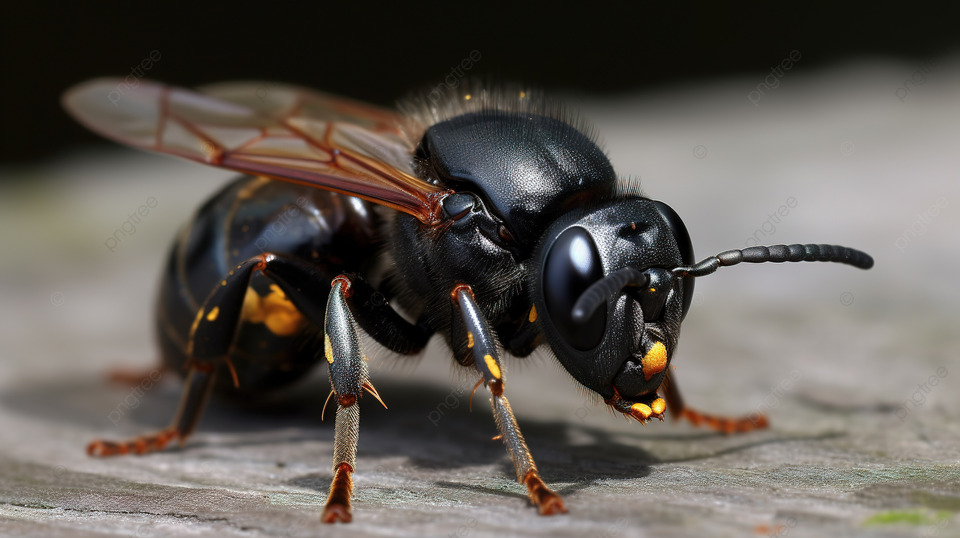Big Black Wasp

The big black wasp, a term often used to describe several species of wasps that are characterized by their large size and predominantly black coloration, is a fascinating and sometimes feared insect. Belonging to the order Hymenoptera, these wasps are known for their role in pollination and as predators that help control pest populations. One of the most recognized species within this category is the Cicada Killer Wasp (Crabronidae: Sphecius speciosus), which is notable for its large size, with some specimens reaching lengths of up to 2 inches (5 cm), and its black body with yellow or orange markings.
Physical Characteristics and Behavior

Big black wasps, such as the Cicada Killer Wasp, exhibit several distinct physical characteristics and behaviors. They are generally larger than other wasp species, with a sturdy body that is well-adapted for their predatory lifestyle. These wasps are also recognized by their bright yellow or orange markings, which serve as a warning to potential predators. In terms of behavior, big black wasps are primarily solitary and non-aggressive, focusing their efforts on hunting and nesting rather than interacting with other wasps or humans. However, female wasps can become defensive if they feel their nest or young are being threatened, at which point they may sting in defense.
Nesting and Hunting Behavior
A critical aspect of the big black wasp’s life cycle involves their nesting and hunting behaviors. These wasps are known to dig complex burrows in well-drained soil, which serve as both nests for their young and storage for food. The female wasp is responsible for constructing and provisioning the nest, capturing insects such as cicadas to feed her larvae. This process involves the wasp paralyzing the insect with its sting and then transporting it back to the nest. The larvae feed on the paralyzed insects, eventually pupating and emerging as adult wasps. This predatory behavior is crucial for controlling pest populations and maintaining ecological balance.
| Species | Length | Coloration | Behavior |
|---|---|---|---|
| Cicada Killer Wasp | Up to 2 inches (5 cm) | Black with yellow or orange markings | Solitary, non-aggressive unless threatened |
| Paper Wasp | 1-2 inches (2.5-5 cm) | Black with yellow or brown markings | Social, can be aggressive when threatened |

Key Points
- The big black wasp is known for its large size and black coloration with yellow or orange markings.
- These wasps are solitary and non-aggressive, focusing on hunting and nesting behaviors.
- The female wasp is responsible for constructing and provisioning the nest, capturing insects to feed her larvae.
- Big black wasps play a crucial role in controlling pest populations and maintaining ecological balance.
- Understanding their behavior and ecological importance can inform more effective pest management strategies.
Ecological Importance and Conservation

Beyond their role in pest control, big black wasps contribute to the ecosystem through pollination and as a food source for other animals. However, like many insect species, they face threats from habitat destruction, pesticide use, and climate change. Conservation efforts aimed at protecting these wasps and their habitats are essential for maintaining the health of ecosystems. This includes preserving natural areas, reducing the use of broad-spectrum pesticides, and promoting biodiversity.
Human Interaction and Safety
While big black wasps are generally not aggressive, they can pose a threat if they feel threatened or if their nest is disturbed. It is essential for individuals to exercise caution around areas where these wasps are known to nest. Avoiding direct interaction with the wasps and their nests can prevent defensive stinging. In cases where nests are located in areas that pose a risk to human safety, professional removal may be necessary.
What is the primary role of big black wasps in the ecosystem?
+The primary role of big black wasps is to control pest populations through their predatory behavior, helping to maintain ecological balance.
Are big black wasps aggressive towards humans?
+Big black wasps are generally solitary and non-aggressive unless they feel their nest or young are being threatened, at which point they may become defensive.
How can individuals contribute to the conservation of big black wasps?
+Individuals can contribute to the conservation of big black wasps by preserving natural habitats, reducing pesticide use, and promoting biodiversity in their communities.
In conclusion, the big black wasp is an intriguing insect that plays a vital role in maintaining the health of ecosystems. Through their predatory behavior, these wasps contribute significantly to pest control and ecological balance. By understanding and appreciating their importance, we can work towards protecting these and other beneficial insect species, ensuring the long-term health of our environments.



